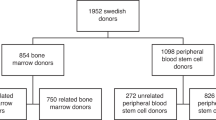Abstract
Granulocyte colony-stimulating factor (G-CSF) is used in healthy donors of peripheral blood stem cells (PBSC) for allogeneic transplantation. However, some data have recently suggested that G-CSF may induce a hypercoagulable state, prompting us to study prospectively 22 PBSC donors before and after G-CSF 5 μg/kg twice daily. We sought evidence for changes in the following parameters: platelet count, von Willebrand factor antigen (vWF:Ag) and activity (vWF activity), β-thromboglobulin (β-TG), platelet factor 4 (PF-4), platelet activation markers (GMP-140 and PAC-1), activated partial thromboplastin time (aPTT), prothrombin time (PT), coagulant factor VIII (FVIII:C), thrombin–antithrombin complex (TAT), prothrombin fragment 1+2 (F1+2), thrombomodulin (TM) and tissue plasminogen activator antigen (tPA:Ag) prior to G-CSF and immediately before leukapheresis. ADP-induced platelet aggregation studies were also performed. G-CSF administration produced only mild discomfort. We found a significant increase in vWF:Ag (from 0.99 ± 0.32 U/ml to 1.83 ± 0.69 U/ml; P < 0.001), in vwf activity (from 1.04 ± 0.34 u/ml to 1.78 ± 0.50 u/ml; P < 0.001) and in fviii:c (from 1.12 ± 0.37 u/ml to 1.73 ± 0.57 u/ml; P < 0.001) after g-csf. of note, four donors with low baseline vwf had a two- to three-fold increase after receiving g-csf. g-csf had no impact on the platelet count, β-tg, pf-4, gmp-140 or pac-1. the final% of platelet aggregation decreased from 73 ± 22% to 37 ± 26% after g-csf (P < 0.001). we found a significant decrease in aptt after g-csf (29.9 ± 3.1 s to 28.3 ± 3.3 s; P = 0.004), but the PT was unaffected. In addition, we also observed a significant increase in TAT, F1+2 and TM, but not in tPA:Ag. Our data suggest that G-CSF may possibly induce a hypercoagulable state by increasing levels of FVIII:C and thrombin generation. In contrast to this information, we found reduced platelet aggregation after G-CSF administration. The clinical implications of these findings remain unclear and larger studies are definitely required.
This is a preview of subscription content, access via your institution
Access options
Subscribe to this journal
Receive 12 print issues and online access
$259.00 per year
only $21.58 per issue
Buy this article
- Purchase on Springer Link
- Instant access to full article PDF
Prices may be subject to local taxes which are calculated during checkout
Similar content being viewed by others
Author information
Authors and Affiliations
Rights and permissions
About this article
Cite this article
LeBlanc, R., Roy, J., Demers, C. et al. A prospective study of G-CSF effects on hemostasis in allogeneic blood stem cell donors. Bone Marrow Transplant 23, 991–996 (1999). https://doi.org/10.1038/sj.bmt.1701756
Received:
Accepted:
Published:
Issue Date:
DOI: https://doi.org/10.1038/sj.bmt.1701756
Keywords
This article is cited by
-
Enhanced thrombin/PAR1 activity promotes G-CSF- and AMD3100-induced mobilization of hematopoietic stem and progenitor cells via NO upregulation
Leukemia (2021)
-
Deep vein thrombosis: a less noticed complication in hematologic malignancies and immunologic disorders
Journal of Thrombosis and Thrombolysis (2020)
-
Extracellular molecules in hematopoietic stem cell mobilisation
International Journal of Hematology (2017)
-
Drug-Induced Thrombosis: An Update
Drug Safety (2013)
-
Pulmonary micro-embolism in a healthy donor following G-CSF administration for mobilization of hemopoietic progenitor cells
Bone Marrow Transplantation (2012)



